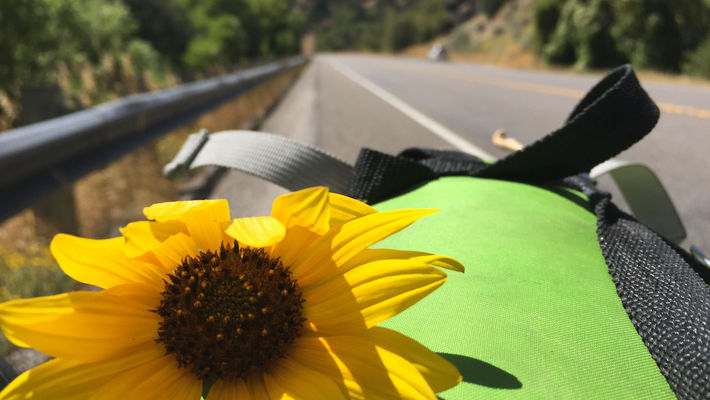
PART IV
The practice of contemplative cycling values this deep inhabitation of the body, foundational in becoming conscious in an embodied way, one might say, “at the cellular level”. The agonies and ecstasies of cycling’s exertion will naturally function as a “pull” on drifting, distractable awareness that returns to the present condition of the ride, but a more conscious appropriation of attention has more power, direction, and utility. An intention such as the use of a simple mantra like “connect with your bike,”, or “perfect revolutions”, has rendered me back into the realm of feeling and sensing as a simple existence unadorned as a bodily motion, training a mind prone to errant wandering to prioritize its focus on just what is happening and no more.
This is an essential base of contemplative practice, one that restores what the Buddhists call “peaceful abiding” along the pace of the ever-renewing flow of spinning wheels that ceaselessly spin because, as Nietzsche's Zarathustra said, “all joys want eternity”. Sharply contrasting to the urgent need for completion, contemplative cycling slaughters the hurry sickness after a destination that a disembodied, afflicted mind holds as its prize, favoring continuous cycling that never ends, achieving no ultimate fruition in finish lines, but, rather, in full inhabitation, the act of savoring and lingering, over fast speed and performance time. Likewise, contemplative cyclists are more focused on cultivating chi, or vital life energy, over burning excess calories.
Deeply inhabiting the body, shifting from excessive preoccupations to direct experience, can be inspired by contemplative cadence. This is a cadence that is generally much slower than competitors or those afflicted with that “hurry sick” are used to aspiring to, but is also not languid, apathetic, torporous movement and might best be described as engaged at the precise intersection of terrain, equipment, physical conditioning, and the whims and weather of the day outside and within the complex, dynamic system of the cyclist. It is a mile-per-hour that is elusive, a hair’s breadth, one that is subtly shifting and not-so-subtly shifting where I live and cycle, in the mountainous string of peaks and valleys in Colorado, as conditions rapidly change in this highly mobile practice. Contemplative cadence, when accessed as a link between machine and musculature, helps fortify the stable base for the moving meditation that supplies a boundless, endless capacity for endurance, an instinctual wellspring of infinitely-sustainable, self-generating, ever-renewing reserves. Maybe this is what we should feel like all of the time, if we were so harmonious with our surroundings and our natural body-mind organization, which, feels oh-so effin good, instead of our usual self-managing, self-interfering, control-towering, manipulating everything – or attempting to. Maybe this is its ultimate purpose, a training for life, what contemplative cycling instructs us in, or brings further into being.
As in taking conscious control of the cadence, the conscious control of the breath, loosely classified as pranayama technique, is what eminent Buddhist scholar-practitioner Thich Nhat Hanh recommends as the most effective tool for focusing a scattered mind. Breath, a dynamic pivot point linking body and mind, as used for centering practice such as “[experience] comes and goes like clouds in a windy sky … conscious breathing is my anchor,” pierces a dense mind and discursive thought like no other when the body is in a state of rapturous exertion.
Over enough mileage, becoming more consciously embodied in continual practice, a certain threshold opens what I’ve often colloquially described as “synch”, or in somewhat fancier terms, “higher-frequency self/world organization”, a melody or a mathematical elegance of motion full of good-feeling, bodily integrity, and “full-cylinder firing”. The Great Harmony becomes available when rigid performance goals, the competitive attitude, and the oppressive mindset of typical exercise as forcing the body to move like a slave horse, fall away like the skins of constricted snakes ready to slither unbound. No excess and no internal divisions. Full presence and attention to the task of continuous, conscious cycling. Steadiness, ease, and efficient movement unlock and become available. The pedal stroke is even and secure. The exertion is propulsively forward-moving. A win over the kind of cycling that flails, awkwardly moves, resists a total commitment, painfully expressing itself on agonized faces. At least while the window of such magic coordination is open, there are surges and the soaring confidences of inexhaustibility. Limbs attain grace. Scenes manifest a synchrony of movement. Flocks of birds, shafts of light, configurations of clouds, barn doors, power poles, stacks of hay bales, patterns of nature, buildings, dwellings, establishments, and the road that cuts through it all intensify, coordinate, encode beauty.
As links between severed worlds just as the essential links in the dynamic mechanism of the bicycle’s chain, the breath and the cadence and the motions of cycling, the practice of continuous movement around the fulcrum of the crankshaft, mend narrow, analytic attention that classifies, categorizes, and labels, thinks it knows. It mends through the drishti, a Sanskrit term meaning “focused gaze”, on the road ahead, bringing forward, through mesmeric concentration, the feeling and sensing as the conscious body, cycling a conscious landscape. The focus on the spinning wheel of self-propulsion is an ideal meditative object. It steadies the larger cycles. It cycles through. The hub is a still, quiet centering point of reference, the ever-present witness; the spokes radially radiate waves of self-generated energy equally in all directions in the constant flux or pulse of life, in a flurry of revolutions. One with the total ride scene, the cyclist settles as the cycle that she actually is. This cycling weaves together frayed dimensions and fragmentations, as does yoga, with which it has much in common, bringing together the separate self with its larger environs, our human nature with towering Nature through the basic, essential partnership of the conscious body and the bike. That interface of contact is perhaps the most crucial to slip into and ride the slipstream of, to keep one tether extended into the mysteries of the dark, interior body whose recesses are where psyche, soul, and dreamstuff live, and one extended into the equally-mysterious expanse of the encompassing world and the limitless, no-ceiling heavens.
Durable material welded and wielded to form this equipmental means holds in its frame and on its saddle the being made of flesh and divinity, matter and mind.















